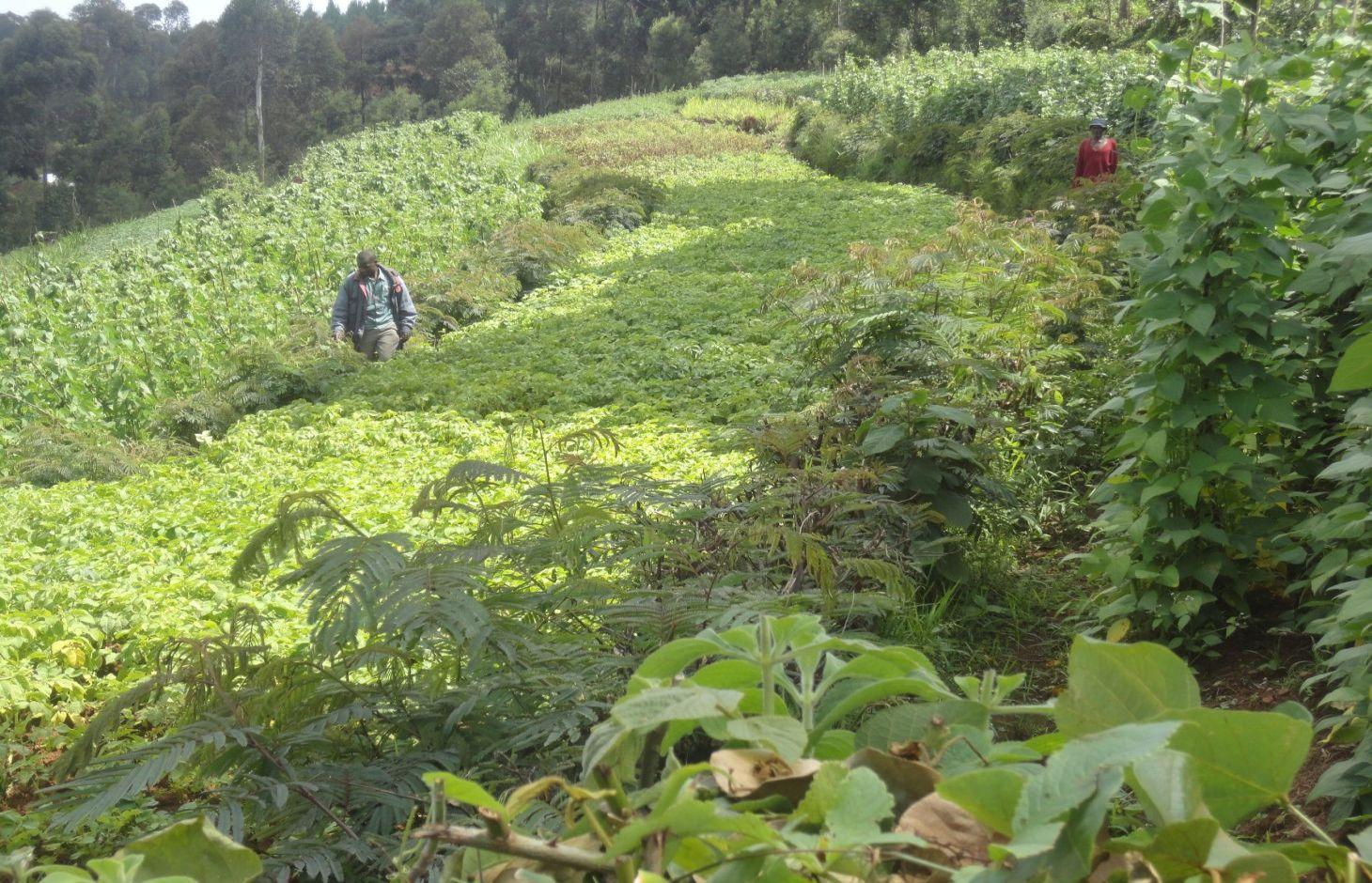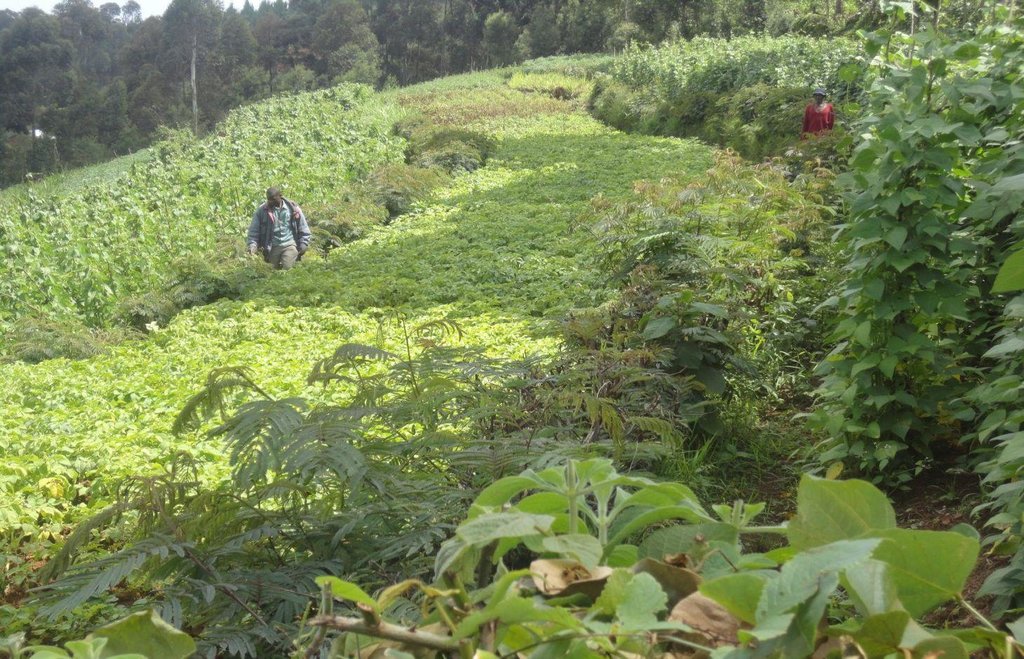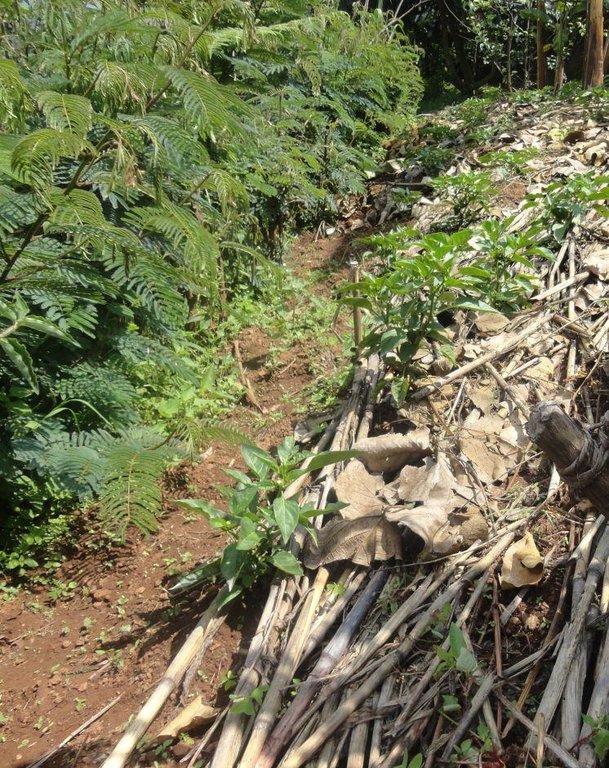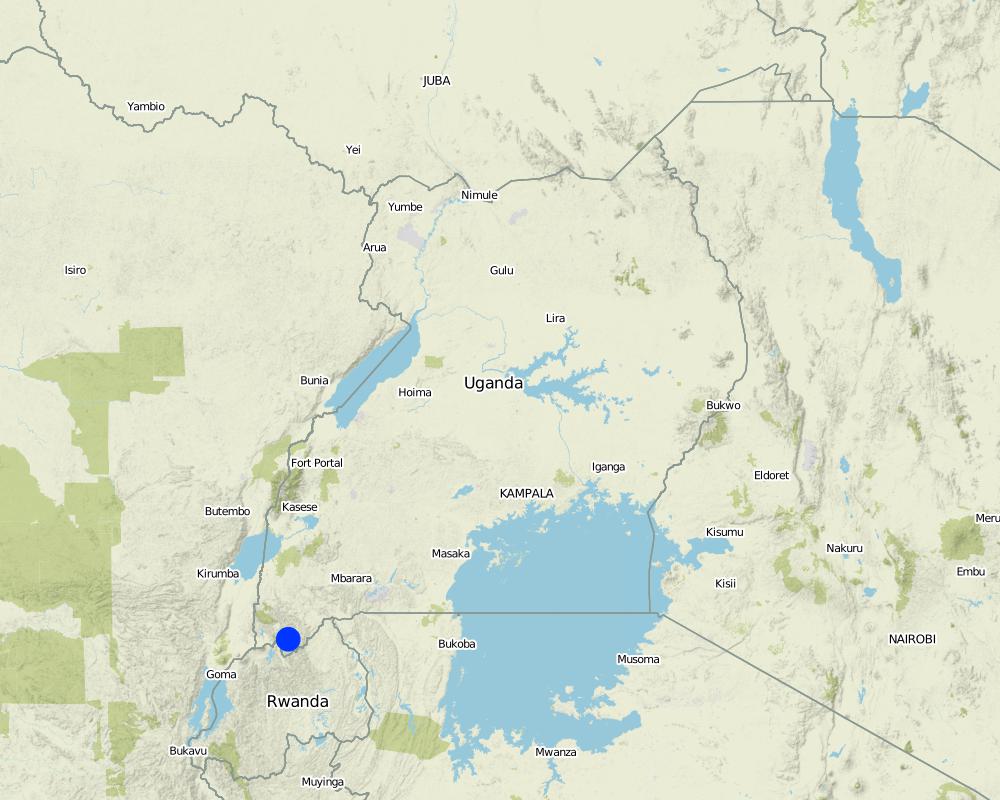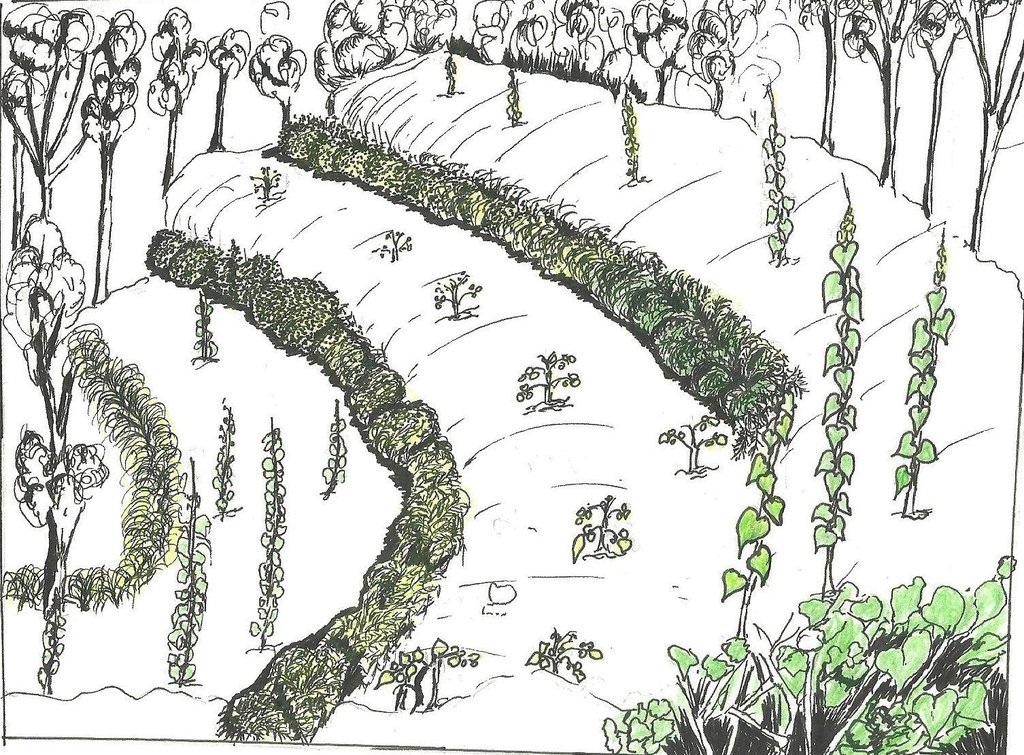Calliandra contour hedges [ยูกันดา]
- ผู้สร้างสรรค์:
- การอัพเดท:
- ผู้รวบรวม: Wilson Bamwerinde
- ผู้เรียบเรียง: –
- ผู้ตรวจสอบ: Alexandra Gavilano
Orugo rwa Calliandra (Rukiga)
technologies_1178 - ยูกันดา
ดูส่วนย่อย
ขยายทั้งหมด ย่อทั้งหมด1. ข้อมูลทั่วไป
1.2 รายละเอียดที่ติดต่อได้ของผู้รวบรวมและองค์กรที่เกี่ยวข้องในการประเมินและการจัดเตรียมทำเอกสารของเทคโนโลยี
ชื่อของโครงการซึ่งอำนวยความสะดวกในการทำเอกสารหรือการประเมินเทคโนโลยี (ถ้าเกี่ยวข้อง)
The Transboundary Agro-ecosystem Management Project for the Kagera River Basin (GEF-FAO / Kagera TAMP )ชื่อขององค์กรซึ่งอำนวยความสะดวกในการทำเอกสารหรือการประเมินเทคโนโลยี (ถ้าเกี่ยวข้อง)
FAO Food and Agriculture Organization (FAO Food and Agriculture Organization) - อิตาลีชื่อขององค์กรซึ่งอำนวยความสะดวกในการทำเอกสารหรือการประเมินเทคโนโลยี (ถ้าเกี่ยวข้อง)
Kabale District Local Government (Kabale District Local Government) - ยูกันดา1.3 เงื่อนไขการใช้ข้อมูลที่ได้บันทึกผ่านทาง WOCAT
ผู้รวบรวมและวิทยากรหลักยอมรับเงื่อนไขเกี่ยวกับการใช้ข้อมูลที่ถูกบันทึกผ่านทาง WOCAT:
ใช่
2. การอธิบายลักษณะของเทคโนโลยี SLM
2.1 การอธิบายแบบสั้น ๆ ของเทคโนโลยี
คำจำกัดความของเทคโนโลยี:
Contour hedges of Calliandra planted on very steep slopes to combat soil erosion by decreasing surface runoff and increasing infiltration.
2.2 การอธิบายแบบละเอียดของเทคโนโลยี
คำอธิบาย:
Calliandra Calothyrsus trees are closely planted along the contours on hilly and steep slopes to create natural and effective barriers for reduction of the surface runoff and retention of eroded sediment. Calliandra hedge barriers are a fairly cheap, effective, and sustainable way of controlling soil erosion and landslides on vulnerable steep slopes, especially where trash lines and Napier grass strips were inadequate to mitigate dispersed and concentrated soil and water runoff. Once established, the living barrier is durable with minimal additional maintenance cost to the farmer apart from pruning. The average length of a hedgerow is 50 to 70 m, corresponding to the width of a single terrace. The height varies according to intended use of the mature shoots. To use the stems as stakes, the hedgerow is allowed to reach a height of 4 to 6 m at maturity while a height of 1 to 2 m is sufficient for harvesting foliage as livestock fodder. The hedge barrier reaches its mature, maintenance level after 12 to 18 months.
Purpose of the Technology: The main purpose of the Calliandra hedge barrier is to reduce soil and water runoff.Calliandra is a leguminous shrub with deep roots that provids additional benefits such as soil stabilization and soil fertility improvement through nitrogen fixing. Calliandra is a source of fodder and its flowers attract bees.
Establishment / maintenance activities and inputs: At the beginning of the rainy season, calliandra seedlings are transplanted from the nursery (0.2m to 0.3m height) and planted in a row (0.3m spacing). In the early stages, gap-filling with more seedlings may be necessary as some fail to get established. A mixture of top soil and manure is applied in the spaces between the seedlings and watering is done to improve the seedling survival rate. The distance between rows is 10 to 15 m and depends on the gradient of the slope. Establishment of hedges starts with construction of an earth banked terrace, creating a trench at the lower end of the terrace. Calliandra seedlings are planted on the higher side of the trench. Measuring off 10 m lengths upwards into the terrace, other rows of Calliandra seedlings are planted along the contour in order to achieve the inter-row spacing. Establishment is manual labor intensive and therefore the community, organized as Farmer Field Schools, participates in the planting, one field at a time. Simple tools such as hand hoes, sokajembe (pick-axe) and shovels are used. Maintenance is achieved by weeding, mulching and cutting back. For it to establish well, Calliandra needs to be weeded to minimize competition with weeds for water and nutrients . The weeds also harbour pests. It may also be necessary to mulch the area around each seedling during the dry season. Where mulching is done, the mulch is placed at least 0.05m away from the plant to reduce pest attacks. Calliandra calothyrsus trees are cut back at a height of 2m to between 0.15m and 1m to improve foliage which is used as fodder for livestock. The hedge is then maintained at a height of 1 to 6 m depending on the intended additional uses. The branches removed can be used as fuel wood or stakes, while leaves can be used as fodder.
Natural / human environment: The hedge barrier may be attacked by pests. Scales are white, powdery insects that attack Calliandra stems. Scales can be controlled using washing detergents such as ‘Omo’ dissolved in water and sprinkled on affected plants using leafy branches or a knapsack sprayer. Black ants can seriously damage trees. They can be controlled by spraying. Other likely pests are crickets and grass hoppers which affect seedlings in nurseries, and Armillaria mellea, a fungus that attacks roots of Calliandra plant causing root rot and eventual death. Affected plants are uprooted and burnt. In addition, calliandra is affected by hot, dry weather. During the hot, dry weather, the hedge barrier becomes weak. However during the wet season it sprouts again, and, if well managed, becomes healthy again. A well-maintained hedge barriers can last well over 20 years.
2.3 รูปภาพของเทคโนโลยี
2.5 ประเทศภูมิภาค หรือสถานที่ตั้งที่เทคโนโลยีได้นำไปใช้และได้รับการครอบคลุมโดยการประเมินนี้
ประเทศ:
ยูกันดา
ภูมิภาค/รัฐ/จังหวัด:
Uganda
ข้อมูลจำเพาะเพิ่มเติมของสถานที่ตั้ง :
Kabale District
แสดงความคิดเห็น:
Boundary points of the Technology area: -1.29294, 29.96006
-1.29336, 29.96027
-1.29327, 29.96084
Total area covered by the SLM Technology is 0.03 km2.
The documented case study area is around 3ha
-1.29371, 29.96095
-1.29345, 29.96091
Map
×2.6 วันที่การดำเนินการ
ถ้าไม่รู้ปีที่แน่นอน ให้ระบุวันที่โดยประมาณ:
- น้อยกว่า 10 ปี (ไม่นานนี้)
2.7 คำแนะนำของเทคโนโลยี
ให้ระบุว่าเทคโนโลยีถูกแนะนำเข้ามาอย่างไร:
- ทางโครงการหรือจากภายนอก
ความคิดเห็น (ประเภทของโครงการ เป็นต้น) :
The technology was introduced by ICRAF in 2006 and scaled-up Kagera TAMP project 2 years ago.
3. การจัดประเภทของเทคโนโลยี SLM
3.2 ประเภทของการใช้ที่ดินในปัจจุบันที่ได้นำเทคโนโลยีไปใช้

พื้นที่ปลูกพืช
- การปลูกพืชล้มลุกอายุปีเดียว
- การปลูกไม้ยืนต้น ไม้พุ่ม
Annual cropping - Specify crops:
- fodder crops - other
- legumes and pulses - beans
Tree and shrub cropping - Specify crops:
- fodder trees (Calliandra, Leucaena leucocephala, Prosopis, etc.)
จำนวนของฤดูเพาะปลูกต่อปี:
- 2
ระบุ:
Longest growing period in days: 120Longest growing period from month to month: February to MaySecond longest growing period in days: 90Second longest growing period from month to month: September to November

ทุ่งหญ้าเลี้ยงสัตว์
ทุ่งหญ้าเลี้ยงสัตว์ที่มีการจัดการแบบเข้มข้นหรือการผลิตอาหารสัตว์:
- ทุ่งหญ้าเลี้ยงสัตว์ที่ได้มีการปรับปรุง (Improved pastures)
- Livestock is grazing on crop residues
แสดงความคิดเห็น:
Livestock density (if relevant):
1-10 LU /km2
Major land use problems (compiler’s opinion): The slopes are steep >30% to very steep >60%), with very high precipitation (>1440 mm). Severe surface erosion and landslides may occur at the beginning of the rains, before sufficient vegetation covers the soil. Continuous cultivation with little external inputs and nutrient transfer affects negatively soil fertility and in results reduces crops growth/vegetation cover, leading to erosion on steep slopes.
Major land use problems (land users’ perception): Floods are common in the valleys over the past ten years.
Improved pasture: Diary hiefers,pigs(largewhite and layers)pasture include calliandra,stellia and elephant grass.
Constraints of settlement / urban: floods invade houses
Constraints of infrastructure network (roads, railways, pipe lines, power lines): transport problem
3.4 การใช้น้ำ
การใช้น้ำของที่ดินที่มีการใช้เทคโนโลยีอยู่:
- จากน้ำฝน
3.6 มาตรการ SLM ที่ประกอบกันเป็นเทคโนโลยี

มาตรการอนุรักษ์ด้วยวิธีพืช
- V1: ต้นไม้และพุ่มไม้คลุมดิน
แสดงความคิดเห็น:
Type of vegetative measures: aligned: -contour
3.7 รูปแบบหลักของการเสื่อมโทรมของที่ดินที่ได้รับการแก้ไขโดยเทคโนโลยี

การกัดกร่อนของดินโดยน้ำ
- Wt (Loss of topsoil): การสูญเสียดินชั้นบนหรือการกัดกร่อนที่ผิวดิน
- Wm (Mass movement): การเคลื่อนตัวของมวลดินหรือดินถล่ม
แสดงความคิดเห็น:
Main causes of degradation: soil management (Poor vegetative cover/no trees to bind soil particles.), Heavy / extreme rainfall (intensity/amounts) (Rainfall intensifying in september and April.), other natural causes (avalanches, volcanic eruptions, mud flows, highly susceptible natural resources, extreme topography, etc.) specify (steep slopes (extreme topography)), population pressure (Population increase/no of people increased per sq km), poverty / wealth (lack of resources to implement known natural resources degradation mitigation measures)
Secondary causes of degradation: education, access to knowledge and support services
3.8 การป้องกัน การลดลง หรือการฟื้นฟูความเสื่อมโทรมของที่ดิน
ระบุเป้าหมายของเทคโนโลยีกับความเสื่อมโทรมของที่ดิน:
- ป้องกันความเสื่อมโทรมของที่ดิน
- ลดความเสื่อมโทรมของดิน
4. ข้อมูลจำเพาะด้านเทคนิค กิจกรรมการนำไปปฏิบัติใช้ ปัจจัยนำเข้า และค่าใช้จ่าย
4.1 แบบแปลนทางเทคนิคของเทคโนโลยี
ข้อมูลจำเพาะด้านเทคนิค (แบบแปลนทางเทคนิคของเทคโนโลยี):
Calliandra trees are planted in rows along the contour. Cutting back is done between 12 and 18 months to a height of 0.5 m. The trees are allowed to grow to between 1 and 6 m and the hedge is maintained at that height. Gap-filling, weeding and trimming are critical for a productive hedge.
Location: Bukoora, Kabale. Kabale/Uganda
Technical knowledge required for field staff / advisors: moderate (Such knowledge as is required to manage the Calliandra nursery, transplant and maintain the plants especially until the first coppice.)
Technical knowledge required for land users: moderate (The land user is responsible for maintaining the technology on his or her land and a good hedge requires diligence)
Main technical functions: control of dispersed runoff: impede / retard, control of concentrated runoff: impede / retard, improvement of ground cover, improvement of topsoil structure (compaction), stabilisation of soil (eg by tree roots against land slides), increase in nutrient availability (supply, recycling,…)
Secondary technical functions: control of raindrop splash, reduction of slope angle, reduction of slope length, increase of infiltration, increase of groundwater level / recharge of groundwater, sediment retention / trapping, sediment harvesting, increase of biomass (quantity)
Aligned: -contour
Vegetative material: T : trees / shrubs
Number of plants per (ha): 670 to 720
Spacing between rows / strips / blocks (m): 10
Vertical interval within rows / strips / blocks (m): 0.4
Width within rows / strips / blocks (m): 0.7
Trees/ shrubs species: Calliandra was planted
Fruit trees / shrubs species: n/a
Perennial crops species: n/a
Grass species: n/a
Other species: n/a
Slope (which determines the spacing indicated above): 40%
If the original slope has changed as a result of the Technology, the slope today is (see figure below): n/a%
Gradient along the rows / strips: <3%
ผู้เขียน:
Byonabye, Prossy, Kagera TAMP, Kabale, Uganda
วันที่:
2013-11-29
4.2 ข้อมูลทั่วไปเกี่ยวกับการคำนวณปัจจัยนำเข้าและค่าใช้จ่าย
อื่นๆ หรือสกุลเงินประจำชาติ (ระบุ):
UGX
If relevant, indicate exchange rate from USD to local currency (e.g. 1 USD = 79.9 Brazilian Real): 1 USD =:
2602.0
ระบุค่าเฉลี่ยของค่าจ้างในการจ้างแรงงานต่อวัน:
3.80
4.3 กิจกรรมเพื่อการจัดตั้ง
| กิจกรรม | Timing (season) | |
|---|---|---|
| 1. | Establishment of Calliandra nursery | Dry season |
| 2. | Plantation of Calliandra seedling on the higher side of the trench | Wet season |
| 3. | Weeding |
4.4 ค่าใช้จ่ายของปัจจัยนำเข้าที่จำเป็นสำหรับการจัดตั้ง
| ปัจจัยนำเข้า | หน่วย | ปริมาณ | ค่าใช้จ่ายต่อหน่วย | ค่าใช้จ่ายทั้งหมดต่อปัจจัยนำเข้า | %ของค่าใช้จ่ายที่ก่อให้เกิดขึ้นโดยผู้ใช้ที่ดิน | |
|---|---|---|---|---|---|---|
| แรงงาน | Labour | 1.0 | 44.6 | 44.6 | 100.0 | |
| อุปกรณ์ | tools | 1.0 | 16.2 | 16.2 | 100.0 | |
| วัสดุด้านพืช | seedlings | 1.0 | 30.4 | 30.4 | 100.0 | |
| วัสดุด้านพืช | seeds | 1.0 | 9.6 | 9.6 | 100.0 | |
| ค่าใช้จ่ายทั้งหมดของการจัดตั้งเทคโนโลยี | 100.8 | |||||
| Total costs for establishment of the Technology in USD | 0.04 | |||||
แสดงความคิดเห็น:
Duration of establishment phase: 18 month(s)
4.5 การบำรุงรักษาสภาพหรือกิจกรรมที่เกิดขึ้นเป็นประจำ
| กิจกรรม | ช่วงระยะเวลา/ความถี่ | |
|---|---|---|
| 1. | Prunning and triming the hedge barriers | wet/dry season |
4.6 ค่าใช้จ่ายของปัจจัยนำเข้าและกิจกรรมที่เกิดขึ้นเป็นประจำที่ต้องการการบำรุงรักษา (ต่อปี)
| ปัจจัยนำเข้า | หน่วย | ปริมาณ | ค่าใช้จ่ายต่อหน่วย | ค่าใช้จ่ายทั้งหมดต่อปัจจัยนำเข้า | %ของค่าใช้จ่ายที่ก่อให้เกิดขึ้นโดยผู้ใช้ที่ดิน | |
|---|---|---|---|---|---|---|
| แรงงาน | labour | 1.0 | 20.8 | 20.8 | 100.0 | |
| อุปกรณ์ | tools | 1.0 | 16.2 | 16.2 | 100.0 | |
| วัสดุด้านพืช | seedlings | 1.0 | 1.0 | 1.0 | 100.0 | |
| อื่น ๆ | 100.0 | |||||
| ค่าใช้จ่ายทั้งหมดของการบำรุงรักษาสภาพเทคโนโลยี | 38.0 | |||||
| Total costs for maintenance of the Technology in USD | 0.01 | |||||
แสดงความคิดเห็น:
Machinery/ tools: I panga,1 watering can, 1hoe.
The cost assesment above refers to steep slopes.
4.7 ปัจจัยสำคัญที่สุดที่มีผลกระทบต่อค่าใช้จ่าย
ปัจจัยสำคัญที่สุดที่มีผลกระทบต่อค่าใช้จ่ายต่างๆ:
The cost of seedlings (0.20 US$ each) and their transport up along steep slopes are the key factors affecting costs and hindering spontaneous adoption of the technology. Otherwise, the technology is acceptable to farmers as benefits are easily visible in the short run.
5. สิ่งแวดล้อมทางธรรมชาติและของมนุษย์
5.1 ภูมิอากาศ
ฝนประจำปี
- < 250 ม.ม.
- 251-500 ม.ม.
- 501-750 ม.ม.
- 751-1,000 ม.ม.
- 1,001-1,500 ม.ม.
- 1,501-2,000 ม.ม.
- 2,001-3,000 ม.ม.
- 3,001-4,000 ม.ม.
- > 4,000 ม.ม.
เขตภูมิอากาศเกษตร
- กึ่งชุ่มชื้น
Thermal climate class: tropics. at the Equator
5.2 สภาพภูมิประเทศ
ค่าเฉลี่ยความลาดชัน:
- ราบเรียบ (0-2%)
- ลาดที่ไม่ชัน (3-5%)
- ปานกลาง (6-10%)
- เป็นลูกคลื่น (11-15%)
- เป็นเนิน (16-30%)
- ชัน (31-60%)
- ชันมาก (>60%)
ธรณีสัณฐาน:
- ที่ราบสูง/ที่ราบ
- สันเขา
- ไหล่เขา
- ไหล่เนินเขา
- ตีนเนิน
- หุบเขา
ระดับความสูง:
- 0-100 เมตร
- 101-500 เมตร
- 501-1,000 เมตร
- 1,001-1,500 เมตร
- 1,501-2,000 เมตร
- 2,001-2,500 เมตร
- 2,501-3,000 เมตร
- 3,001-4,000 เมตร
- > 4,000 เมตร
5.3 ดิน
ค่าเฉลี่ยความลึกของดิน:
- ตื้นมาก (0-20 ซ.ม.)
- ตื้น (21-50 ซ.ม.)
- ลึกปานกลาง (51-80 ซ.ม.)
- ลึก (81-120 ซ.ม.)
- ลึกมาก (>120 ซ.ม.)
เนื้อดิน (ดินชั้นบน):
- หยาบ/เบา (ดินทราย)
- ปานกลาง (ดินร่วน ทรายแป้ง)
อินทรียวัตถุในดิน:
- ปานกลาง (1-3%)
- ต่ำ (<1%)
5.4 ความเป็นประโยชน์และคุณภาพของน้ำ
ระดับน้ำใต้ดิน:
> 50 เมตร
น้ำไหลบ่าที่ผิวดิน:
ไม่ดีหรือไม่มีเลย
5.5 ความหลากหลายทางชีวภาพ
ความหลากหลายทางชนิดพันธุ์:
- ต่ำ
5.6 ลักษณะของผู้ใช้ที่ดินที่นำเทคโนโลยีไปปฏิบัติใช้
แนวทางการตลาดของระบบการผลิต:
- mixed (subsistence/ commercial)
รายได้ที่มาจากนอกฟาร์ม:
- < 10% ของรายได้ทั้งหมด
ระดับของความมั่งคั่งโดยเปรียบเทียบ:
- จน
- พอมีพอกิน
เป็นรายบุคคล/ครัวเรือน:
- เป็นรายบุคคล/ครัวเรือน
ระดับของการใช้เครื่องจักรกล:
- งานที่ใช้แรงกาย
เพศ:
- หญิง
- ชาย
ระบุลักษณะอื่นๆที่เกี่ยวข้องของผู้ใช้ที่ดิน:
Difference in the involvement of women and men: Maintenance such as pruning trimming is mostly done by the men, but the other activities are done by both men and women.
Population density: 200-500 persons/km2
Annual population growth: 2% - 3%; 3%
5% of the land users are rich and own 40% of the land.
30% of the land users are average wealthy and own 30% of the land (meets basic needs/necesities).
45% of the land users are poor and own 20% of the land.
20% of the land users are poor and own 10% of the land.
Off-farm income specification: Crop and animal production greatly increased for land users implementing conservation measures , compared to those who do not implement.
5.7 Average area of land used by land users applying the Technology
- < 0.5 เฮกตาร์
- 0.5-1 เฮกตาร์
- 1-2 เฮกตาร์
- 2-5 เฮกตาร์
- 5-15 เฮกตาร์
- 15-50 เฮกตาร์
- 50-100 เฮกตาร์
- 100-500 เฮกตาร์
- 500-1,000 เฮกตาร์
- 1,000-10,000 เฮกตาร์
- >10,000 เฮกตาร์
พิจารณาว่าเป็นขนาดเล็ก กลาง หรือขนาดใหญ่ (ซึ่งอ้างอิงถึงบริบทระดับท้องถิ่น):
- ขนาดเล็ก
5.8 กรรมสิทธิ์ในที่ดิน สิทธิในการใช้ที่ดินและสิทธิในการใช้น้ำ
กรรมสิทธิ์ในที่ดิน:
- รายบุคคล ไม่ได้รับสิทธิครอบครอง
สิทธิในการใช้ที่ดิน:
- รายบุคคล
แสดงความคิดเห็น:
The land belongs to an individual with no title but has all the rights over it.
5.9 การเข้าถึงบริการและโครงสร้างพื้นฐาน
สุขภาพ:
- จน
- ปานกลาง
- ดี
การศึกษา:
- จน
- ปานกลาง
- ดี
ความช่วยเหลือทางด้านเทคนิค:
- จน
- ปานกลาง
- ดี
ตลาด:
- จน
- ปานกลาง
- ดี
พลังงาน:
- จน
- ปานกลาง
- ดี
ถนนและการขนส่ง:
- จน
- ปานกลาง
- ดี
น้ำดื่มและการสุขาภิบาล:
- จน
- ปานกลาง
- ดี
บริการด้านการเงิน:
- จน
- ปานกลาง
- ดี
n/an/an/an/a:
- จน
- ปานกลาง
- ดี
6. ผลกระทบและสรุปคำบอกกล่าว
6.1 ผลกระทบในพื้นที่ดำเนินการ (On-site) จากการใช้เทคโนโลยี
ผลกระทบทางด้านเศรษฐกิจและสังคม
การผลิต
การผลิตพืชผล
จำนวนก่อน SLM:
150
หลังจาก SLM:
700
คุณภาพพืชที่ใช้เลี้ยงปศุสัตว์
จำนวนก่อน SLM:
-
หลังจาก SLM:
-
การผลิตสัตว์
จำนวนก่อน SLM:
-
หลังจาก SLM:
25
พื้นที่สำหรับการผลิต
รายได้และค่าใช้จ่าย
รายได้จากฟาร์ม
จำนวนก่อน SLM:
1.5 million
หลังจาก SLM:
3.5million
ผลกระทบด้านสังคมวัฒนธรรมอื่น ๆ
ความมั่นคงด้านอาหาร / พึ่งตนเองได้
SLM หรือความรู้เรื่องความเสื่อมโทรมของที่ดิน
จำนวนก่อน SLM:
-
หลังจาก SLM:
-
การบรรเทาความขัดแย้ง
ผลกระทบด้านนิเวศวิทยา
วัฐจักรน้ำหรือน้ำบ่า
น้ำไหลบ่าที่ผิวดิน
ดิน
ความชื้นในดิน
สิ่งปกคลุมดิน
การสูญเสียดิน
การหมุนเวียนและการเติมของธาตุอาหาร
ความหลากหลายทางชีวภาพของพืชและสัตว์
มวลชีวภาพ/เหนือดินชั้น C
ความหลากหลายทางชีวภาพของพืช
ผลกระทบด้านนิเวศวิทยาอื่น ๆ
increased pests
6.2 ผลกระทบนอกพื้นที่ดำเนินการ (Off-site) จากการใช้เทคโนโลยี
น้ำท่วมพื้นที่ท้ายน้ำ
การทับถมของดินตะกอนพื้นที่ท้ายน้ำ
ความเสียหายต่อพื้นที่เพาะปลูกของเพื่อนบ้าน
จำนวนก่อน SLM:
-
หลังจาก SLM:
-
ความเสียหายต่อโครงสร้างพื้นฐานของรัฐหรือของเอกชน
จำนวนก่อน SLM:
-
หลังจาก SLM:
-
6.3 การเผชิญและความตอบสนองของเทคโนโลยีต่อการเปลี่ยนแปลงสภาพภูมิอากาศที่ค่อยเป็นค่อยไป และสภาพรุนแรงของภูมิอากาศ / ภัยพิบัติ (ที่รับรู้ได้โดยผู้ใช้ที่ดิน)
การเปลี่ยนแปลงสภาพภูมิอากาศที่ค่อยเป็นค่อยไป
การเปลี่ยนแปลงสภาพภูมิอากาศที่ค่อยเป็นค่อยไป
| ฤดู | increase or decrease | เทคโนโลยีมีวิธีการรับมืออย่างไร | |
|---|---|---|---|
| อุณหภูมิประจำปี | เพิ่มขึ้น | ดี |
สภาพรุนแรงของภูมิอากาศ (ภัยพิบัติ)
ภัยพิบัติทางอุตุนิยมวิทยา
| เทคโนโลยีมีวิธีการรับมืออย่างไร | |
|---|---|
| พายุฝนประจำท้องถิ่น | ดี |
ภัยพิบัติจากสภาพภูมิอากาศ
| เทคโนโลยีมีวิธีการรับมืออย่างไร | |
|---|---|
| ภัยจากฝนแล้ง | ดี |
ภัยพิบัติจากน้ำ
| เทคโนโลยีมีวิธีการรับมืออย่างไร | |
|---|---|
| น้ำท่วมตามปกติ (แม่น้ำ) | ดี |
ผลลัพธ์ตามมาที่เกี่ยวข้องกับภูมิอากาศอื่น ๆ
ผลลัพธ์ตามมาที่เกี่ยวข้องกับภูมิอากาศอื่น ๆ
| เทคโนโลยีมีวิธีการรับมืออย่างไร | |
|---|---|
| ช่วงการปลูกพืชที่ลดลงมา | ไม่ทราบ |
| n/a |
6.4 การวิเคราะห์ค่าใช้จ่ายและผลประโยชน์ที่ได้รับ
ผลประโยชน์ที่ได้รับเปรียบเทียบกับค่าใช้จ่ายในการจัดตั้งเป็นอย่างไร (จากมุมมองของผู้ใช้ที่ดิน)
ผลตอบแทนระยะสั้น:
ด้านลบ
ผลตอบแทนระยะยาว:
ด้านบวกอย่างมาก
ผลประโยชน์ที่ได้รับเปรียบเทียบกับค่าใช้จ่ายในการบำรุงรักษาหรือต้นทุนที่เกิดขึ้นซ้ำอีก เป็นอย่างไร (จากมุมมองของผู้ใช้ที่ดิน)
ผลตอบแทนระยะสั้น:
ด้านลบ
ผลตอบแทนระยะยาว:
ด้านบวก
แสดงความคิดเห็น:
Benefits are high compared to establishment and maintenance cost
6.5 การปรับตัวของเทคโนโลยี
แสดงความคิดเห็น:
88% of land user families have adopted the Technology with external material support
45 land user families have adopted the Technology with external material support
12% of land user families have adopted the Technology without any external material support
6 land user families have adopted the Technology without any external material support
There is a moderate trend towards spontaneous adoption of the Technology
Comments on adoption trend: The technology is appreciated by most farmers but adoption is limited by cost of seedlings and transportation up steep slopes
6.7 จุดแข็ง / ข้อได้เปรียบ / โอกาสของเทคโนโลยี
| จุดแข็ง / ข้อได้เปรียบ / โอกาสในทัศนคติของผู้ใช้ที่ดิน |
|---|
|
Calliandra binds the soil, thus reduces landslides. How can they be sustained / enhanced? It should be maintained through proper management |
|
Adds scenic beauty on a plot How can they be sustained / enhanced? By regular trimming |
|
Calliandra is good and attractive to bees How can they be sustained / enhanced? Leave every second or third row to flower |
| จุดแข็ง / ข้อได้เปรียบ / โอกาสในทัศนคติของผู้รวบรวมหรือวิทยากรหลัก |
|---|
|
It is easy to establish and maintain How can they be sustained / enhanced? Promote education campaign and spread information |
|
It has helped to increase crop and animal production How can they be sustained / enhanced? By proper management and not overgrazing animals |
|
Stabilize the soil and strenghtening resistance to intensive rainfall and fast runoff How can they be sustained / enhanced? Promote technology through increased community mobilization |
|
Very effective to reduce soil erosion How can they be sustained / enhanced? Combine with other practicies e.g. mulching |
6.8 จุดอ่อน / ข้อเสียเปรียบ / ความเสี่ยงของเทคโนโลยีและวิธีการแก้ไข
| จุดอ่อน / ข้อเสียเปรียบ / ความเสี่ยงในทัศนคติของผู้รวบรวมหรือวิทยากรหลัก | มีวิธีการแก้ไขได้อย่างไร |
|---|---|
| The hedge barrier is ineffective before 12 months | Combine with trash lines before establishment |
| Technology harbors nesting birds | Ensure regular trimming of Calliandra to reasonable height and use scarecrows |
| Needs at least 2 seasons to establish | Apply manure and water to the seedlings to ensure accelerated growth |
| May reduce the amount of sunlight available to young crops if left untrimmed | Trim regularly |
| Extra cost in protecting from damage by livestock | Inter-crop with other fodder species to act as alternative fodder for livestock |
7. การอ้างอิงและการเชื่อมต่อ
7.1 วิธีการและแหล่งข้อมูล
7.2 การอ้างอิงถึงสิ่งตีพิมพ์
หัวข้อ, ผู้เขียน, ปี, หมายเลข ISBN:
Kagera TAMP Project website
ชื่อเรื่อง ผู้เขียน ปี ISBN:
http://www.fao.org/nr/kagera/en/
ลิงก์และโมดูล
ขยายทั้งหมด ย่อทั้งหมดลิงก์
ไม่มีลิงก์
โมดูล
ไม่มีโมดูล


